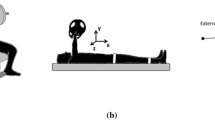Abstract
In the presented research, a kinematic and electromyographic study was performed on one world-class male elite handbiker (UCI class H3.2). Activity of 14 muscles of the upper body were measured with surface electromyography (EMG), and a motion analysis of the athlete’s movement was performed concurrently for different backrest positions, crank lengths, and crank heights at three power levels (130, 160 and 190 W). Kinematics in terms of elbow and wrist angle, muscular on-off timing, EMG amplitudes, and integrated EMG were calculated. Results showed that little changes occurred for kinematic parameters and changes in position led to a shift in muscular timing. However, no indication for immediate improvement to the athlete’s preferred original position could be observed.









Similar content being viewed by others
References
Union Cycliste International (2015) Para cycling—about. http://www.uci.ch/para-cycling/about/
Union Cycliste International (2014) UCI cycling regulations part 16 para-cycling. www.uci.ch/includes/asp/getTarget.asp?type=FILE&id=MzQwMzY
Double Performance BV (2008) Handbike performance. http://www.doubleperformance.nl/downloads/Artikel%20Handbike%20Performance.pdf
Abel T, Vega S, Bleicher I, Platen P (2003) Handbiking: physiological responses to synchronous and asynchronous crank montage. Eur J Sport Sci 3(4):1–9
van der Woude LHV, Bosmans I, Bervoets B, Veeger HEJ (2000) Handcycling: different modes and gear ratios. J Med Eng Technol 24(6):242–249. doi:10.1080/030919000300037168. http://www.tandfonline.com/doi/abs/10.1080/030919000300037168. http://www.tandfonline.com/doi/pdf/10.1080/030919000300037168
van der Woude LH, Horstman A, Faas P, Mechielsen S, Bafghi HA, de Koning JJ (2008) Power output and metabolic cost of synchronous and asynchronous submaximal and peak level hand cycling on a motor driven treadmill in able-bodied male subjects. Med Eng Phys 30(5):574–580
Faupin A, Gorce P, Meyer C (2011) Effects of type and mode of propulsion on hand-cycling biomechanics in nondisabled subjects. J Rehabil Res Dev 48(9):1049–1060
Böhm H, Krämer C, Senner V (2006) Optimization of the handbike’s drive concept—mathematical approach. In: The engineering of sport 6. Springer, New York, pp 121–125. doi:10.1007/978-0-387-46051-2_22
Krämer C, Klöpfer I, Senner V, Peters C (2006) Optimization of the handbike’s drive concept—experimental approach. In: The engineering of sport 6. Springer, New York, pp 313–318. doi:10.1007/978-0-387-46051-2_56
Zeller S, Abel T (2011) Auswirkungen nicht zirkulärer kettenblätter auf physiologische parameter im handcyclesport. In: BISp-Jahrbuch Forschungsförderung 2010/11, Bundesinstitut für Sportwissenschaft, Bonn, pp 1–6. http://www.bisp.de/SharedDocs/Downloads/Publikationen/Jahrbuch/Jb_201011_Artikel/Abel_85_90.pdf?__blob=publicationFile&v=1
Krämer C, Schneider G, Böhm H, Klöpfer-Krämer I, Senner V (2009b) Effect of different handgrip angles on work distribution during hand cycling at submaximal power levels. Ergonomics 52(10):1276–1286. doi:10.1080/00140130902971916 (pMID: 19626501)
Faupin A, Gorce P, Campillo P, Thevenon A, Rmy-Nris O (2006) Kinematic analysis of handbike propulsion in various gear ratios: implications for joint pain. Clin Biomech 21(6):560–566. doi:10.1016/j.clinbiomech.2006.01.001
Faupin A, Gorce P, Meyer C, Thevenon A (2008) Effects of backrest positioning and gear ratio on nondisabled subjects’ handcycling sprinting performance and kinematics. J Rehabil Res Dev 45(1):109
Arnet U, van Drongelen S, Schlüssel M, Lay V, van der Woude LHV, Veeger HEJ (2014) The effect of crank position and backrest inclination on shoulder load and mechanical efficiency during handcycling. Scand J Med Sci Sports 24(2):386–394. doi:10.1111/j.1600-0838.2012.01524.x
Goosey-Tolfrey VL, Alfano H, Fowler N (2008) The influence of crank length and cadence on mechanical efficiency in hand cycling. Eur J Appl Physiol 102(2):189–194
Krämer C, Hilker L, Böhm H (2009a) Influence of crank length and crank width on maximal hand cycling power and cadence. Eur J Appl Physiol 106(5):749–757. doi:10.1007/s00421-009-1062-1
Abel T, Bonin D, Albracht K, Zeller S, Brüggemann G, Burkett B, Strüder H (2010) Kinematic profile of the elite handcyclist. In: ISBS-conference proceedings archive, vol 1
Abel T, Bonin D, Strüder HK (2010) Evaluation des physiologischen und biomechanischen profils von nationalen und internationalen spitzenathletinnen und -athleten der sportart handcycling vor und während der paralympics in peking. In: BISp-Jahrbuch Forschungsförderung 2009/10, Bundesinstitut für Sportwissenschaft, Bonn, pp 107–110. http://www.bisp.de/SharedDocs/Downloads/Publikationen/Jahrbuch/Jb_200910_Artikel/Abel_107_110.pdf?__blob=publicationFile&v=1
Faupin A, Gorce P, Watelain E, Meyer C, Thevenon A (2010) A biomechanical analysis of handcycling: a case study. J Appl Biomech 26(2):240–245
Litzenberger S, Mally F, Sabo A (2015) Influence of different seating and crank positions on muscular activity in elite handcycling—a case study. Proc Eng 112:355–360
Hermens HJ, Freriks B, Merletti R, Stegeman D, Blok J, Rau G, Disselhorst-Klug C, Hägg G (1999) European recommendations for surface electromyography. Roessingh Research and Development, Enschede
Burden AM, Lewis SE, Willcox E (2014) The effect of manipulating root mean square window length and overlap on reliability, inter-individual variability, statistical significance and clinical relevance of electromyograms. Manual Ther 19(6):595–601. doi:10.1016/j.math.2014.06.003. http://www.sciencedirect.com/science/article/pii/S1356689X14001210
Doheny EP, Lowery MM, FitzPatrick DP, OMalley MJ (2008) Effect of elbow joint angle on forceemg relationships in human elbow flexor and extensor muscles. J Electromyogr Kinesiol 18(5):760–770. doi:10.1016/j.jelekin.2007.03.006. http://www.sciencedirect.com/science/article/pii/S1050641107000600
Murray WM, Buchanan TS, Delp SL (2000) The isometric functional capacity of muscles that cross the elbow. J Biomech 33(8):943–952. doi:10.1016/S0021-9290(00)00051-8. www.jbiomech.com/article/S0021-9290(00)00051--8/abstract
Philippou A, Bogdanis G, Nevill A, Maridaki M (2004) Changes in the angle-force curve of human elbow flexors following eccentric and isometric exercise. Eur J Appl Physiol 93(1–2):237–244. doi:10.1007/s00421-004-1209-z
Author information
Authors and Affiliations
Corresponding author
Rights and permissions
About this article
Cite this article
Litzenberger, S., Mally, F. & Sabo, A. Biomechanics of elite recumbent handcycling: a case study. Sports Eng 19, 201–211 (2016). https://doi.org/10.1007/s12283-016-0206-x
Published:
Issue Date:
DOI: https://doi.org/10.1007/s12283-016-0206-x




